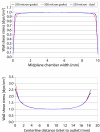Open access to novel dual flow chamber technology for in vitro cell mechanotransduction, toxicity and pharamacokinetic studies
- PMID: 18053207
- PMCID: PMC2235874
- DOI: 10.1186/1475-925X-6-46
Open access to novel dual flow chamber technology for in vitro cell mechanotransduction, toxicity and pharamacokinetic studies
Abstract
Background: A major stumbling block for researchers developing experimental models of mechanotransduction is the control of experimental variables, in particular the transmission of the mechanical forces at the cellular level. A previous evaluation of state of the art commercial perfusion chambers showed that flow regimes, applied to impart a defined mechanical stimulus to cells, are poorly controlled and that data from studies in which different chambers are utilized can not be compared, even if the target stress regimes are comparable.
Methods: This study provides a novel chamber design to provide both physiologically-based flow regimes, improvements in control of experimental variables, as well as ease of use compared to commercial chambers. This novel design achieves controlled stresses through five gasket designs and both single- and dual-flow regimes.
Results: The imparted shear stress within the gasket geometry is well controlled. Fifty percent of the entire area of the 10 x 21 mm universal gasket (Gasket I, designed to impart constant magnitude shear stresses in the center of the chamber where outcome measures are taken), is exposed to target stresses. In the 8 mm diameter circular area at the center of the chamber (where outcome measures are made), over 92% of the area is exposed to the target stress (+/- 2.5%). In addition, other gasket geometries provide specific gradients of stress that vary with distance from the chamber inlet. Bench-top testing of the novel chamber prototype shows improvements, in the ease of use as well as in performance, compared to the other commercial chambers. The design of the chamber eliminates flow deviations due to leakage and bubbles and allows actual flow profiles to better conform with those predicted in computational models.
Conclusion: The novel flow chamber design provides predictable and well defined mechanical forces at the surface of a cell monolayer, showing improvement over previously tested commercial chambers. The predictability of the imparted stress improves both experiment repeatability as well as the accuracy of inter-study comparisons. Carefully controlling the stresses on cells is critical in effectively mimicking in vivo situations. Overall, the improved perfusion flow chamber provides the needed resolution, standardization and in vitro model analogous to in vivo conditions to make the step towards greater use in research and the opportunity to enter the diagnostic and therapeutic market.
Figures
















Similar articles
-
The imperative for controlled mechanical stresses in unraveling cellular mechanisms of mechanotransduction.Biomed Eng Online. 2006 May 3;5:27. doi: 10.1186/1475-925X-5-27. Biomed Eng Online. 2006. PMID: 16672051 Free PMC article.
-
A serial dilution microfluidic device for cytotoxicity assays.Conf Proc IEEE Eng Med Biol Soc. 2006;2006:2836-9. doi: 10.1109/IEMBS.2006.259270. Conf Proc IEEE Eng Med Biol Soc. 2006. PMID: 17946141
-
Investigating the effects of fluid shear forces on cellular responses to profiled surfaces in-vitro: a computational and experimental investigation.Annu Int Conf IEEE Eng Med Biol Soc. 2007;2007:5387-90. doi: 10.1109/IEMBS.2007.4353560. Annu Int Conf IEEE Eng Med Biol Soc. 2007. PMID: 18003226
-
Macro- and microscale fluid flow systems for endothelial cell biology.Lab Chip. 2010 Jan 21;10(2):143-60. doi: 10.1039/b913390a. Epub 2009 Oct 9. Lab Chip. 2010. PMID: 20066241 Review.
-
Microfluidic devices for in vitro studies on liver drug metabolism and toxicity.Integr Biol (Camb). 2011 May;3(5):509-21. doi: 10.1039/c0ib00119h. Epub 2011 Feb 17. Integr Biol (Camb). 2011. PMID: 21331391 Review.
Cited by
-
Mechanical modulation of osteochondroprogenitor cell fate.Int J Biochem Cell Biol. 2008;40(12):2720-38. doi: 10.1016/j.biocel.2008.05.011. Epub 2008 May 24. Int J Biochem Cell Biol. 2008. PMID: 18620888 Free PMC article. Review.
-
In situ spatiotemporal mapping of flow fields around seeded stem cells at the subcellular length scale.PLoS One. 2010 Sep 17;5(9):e12796. doi: 10.1371/journal.pone.0012796. PLoS One. 2010. PMID: 20862249 Free PMC article.
-
Stem cell mechanoadaptation. I. Effect of microtubule stabilization and volume changing stresses on cytoskeletal remodeling.APL Bioeng. 2025 Jan 7;9(1):016102. doi: 10.1063/5.0231273. eCollection 2025 Mar. APL Bioeng. 2025. PMID: 39801500 Free PMC article.
-
Structure-function relationships in the stem cell's mechanical world B: emergent anisotropy of the cytoskeleton correlates to volume and shape changing stress exposure.Mol Cell Biomech. 2011 Dec;8(4):297-318. Mol Cell Biomech. 2011. PMID: 22338708 Free PMC article.
-
Mapping the mechanome of live stem cells using a novel method to measure local strain fields in situ at the fluid-cell interface.PLoS One. 2012;7(9):e43601. doi: 10.1371/journal.pone.0043601. Epub 2012 Sep 10. PLoS One. 2012. PMID: 22970134 Free PMC article.
References
-
- Hung CT, Pollack SR, Reilly TM, Brighton CT. Real-time calcium response of cultured bone cells to fluid flow. Clin Orthop. 1995;313:256–269. - PubMed
-
- Nauman EA, Satcher RL, Keaveny TM, Halloran BP, Bikle DD. Osteoblasts respond to pulsatile fluid flow with short-term increases in PGE(2) but no change in mineralization. J Appl Physiol. 2001;90:1849–1854. - PubMed
Publication types
MeSH terms
Grants and funding
LinkOut - more resources
Full Text Sources
Other Literature Sources

